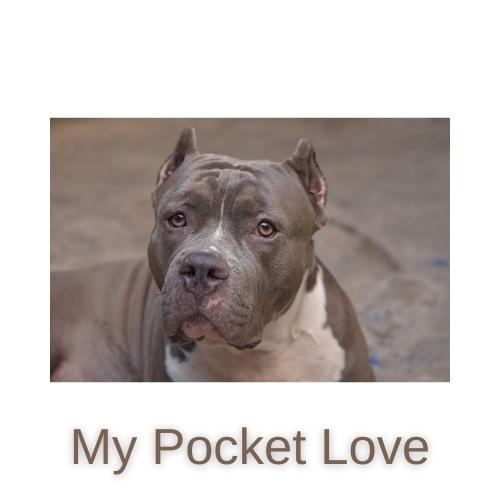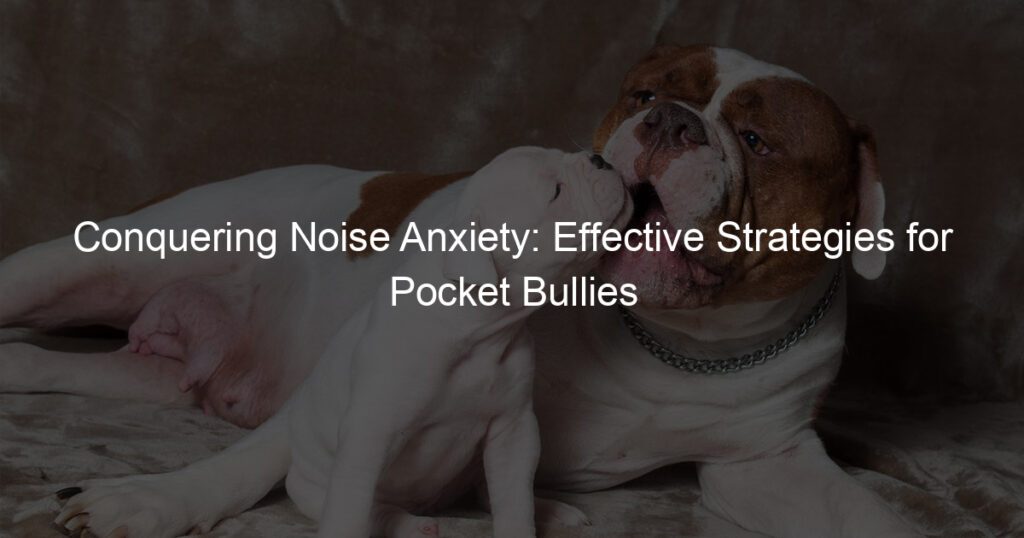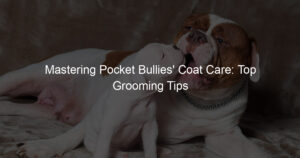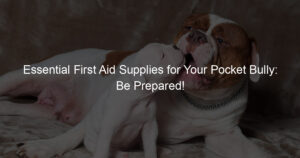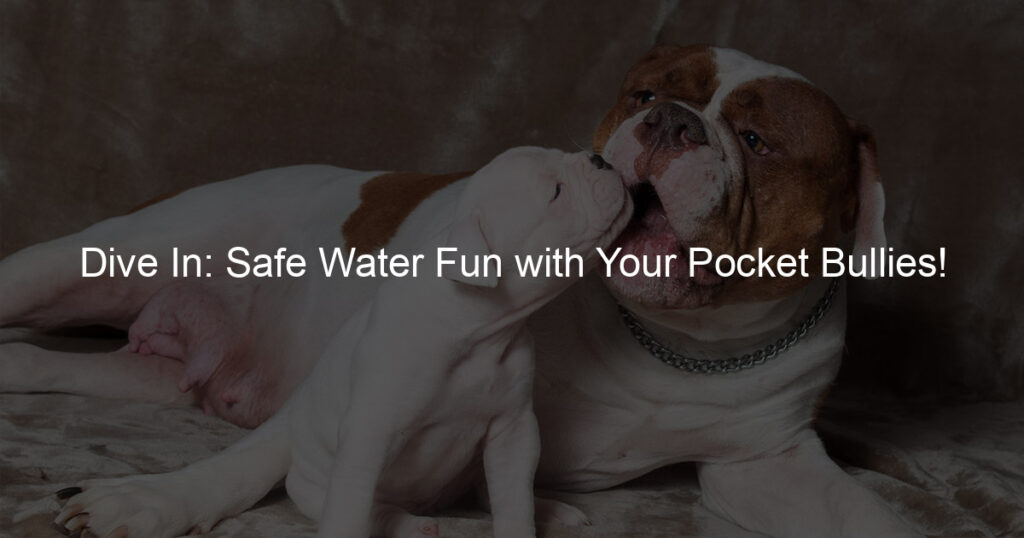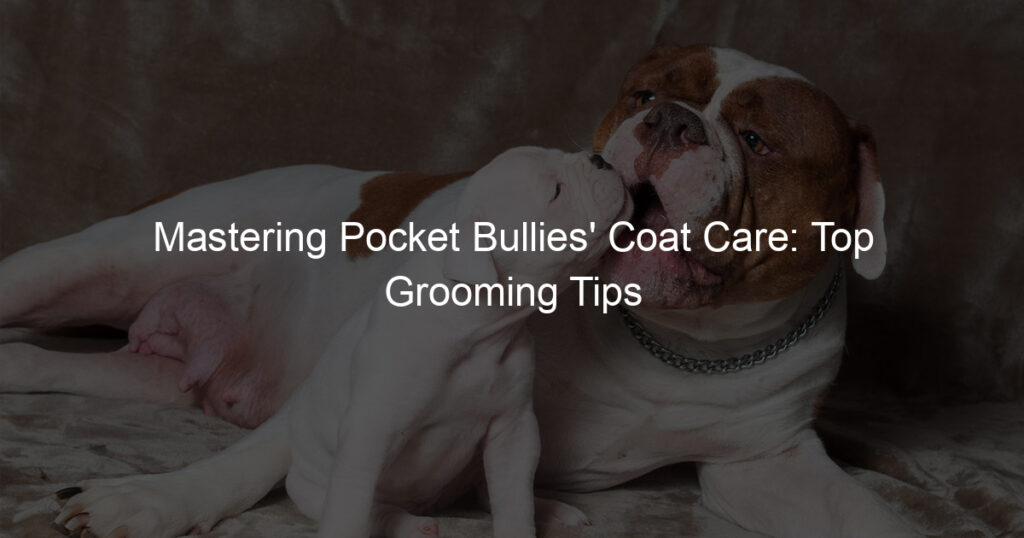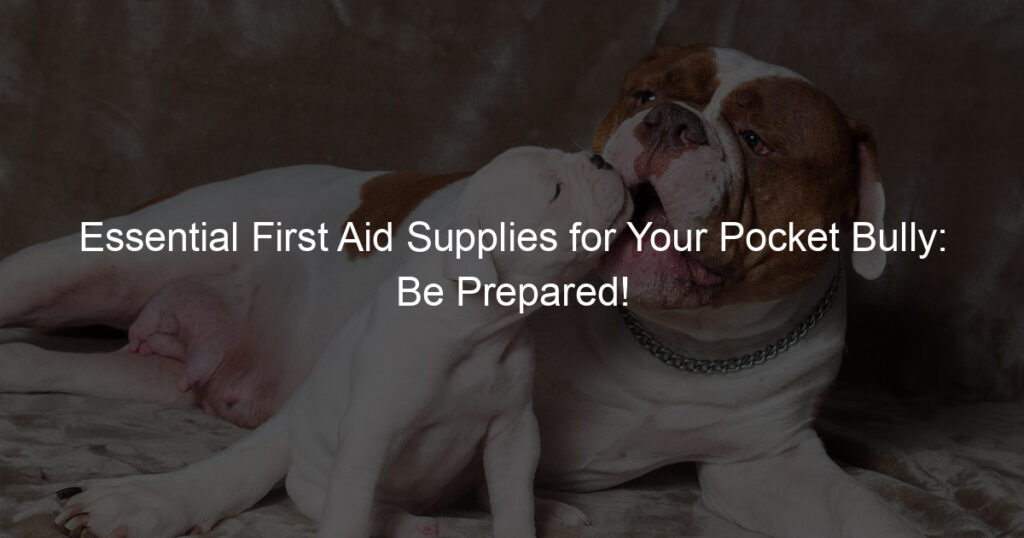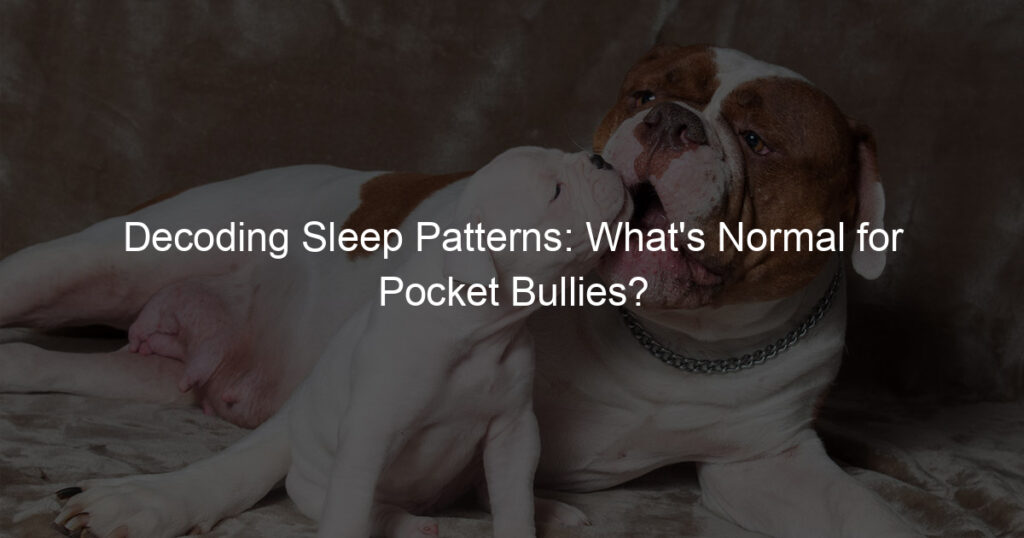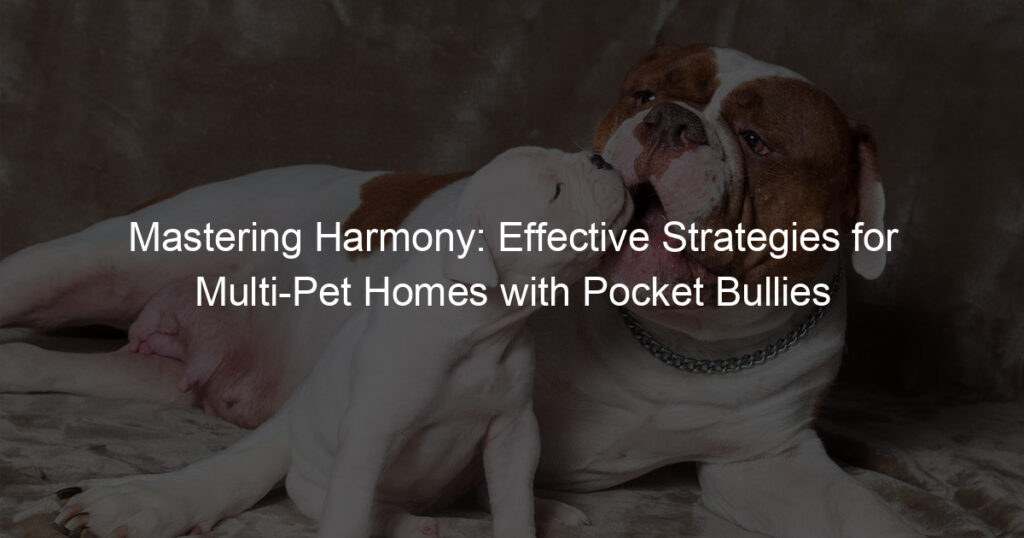
Understanding Pocket Bullies Noise Anxiety
Noise anxiety is a common issue among dogs, and Pocket Bullies are no exception. This type of anxiety can cause significant stress for your pet, and understanding it is the first step towards helping them cope.
- Defining Noise Anxiety in Pocket Bullies
- Common Signs of Noise Anxiety in Dogs
- Panting or drooling excessively
- Trembling or shaking
- Hiding or trying to escape
- Barking or howling
- Chewing or destructive behavior
- Why Pocket Bullies are Prone to Noise Anxiety
Noise anxiety in Pocket Bullies is a fear or discomfort triggered by loud or unexpected sounds. It’s not just about the noise being loud; it’s about it being unexpected or unfamiliar. This can include anything from thunderstorms and fireworks to the sound of a vacuum cleaner or a door slamming.
Signs of noise anxiety in dogs can vary, but there are some common symptoms to look out for. These include:
If your Pocket Bully shows any of these signs during a loud event, they may be experiencing noise anxiety.
Pocket Bullies, like many other breeds, have a heightened sense of hearing compared to humans. This means they can hear sounds we can’t and at a much louder volume. This heightened sense of hearing can make them more sensitive to loud or unexpected noises, leading to noise anxiety.
Understanding your Pocket Bully’s noise anxiety is the first step towards helping them. By recognizing the signs and understanding why they may be prone to this type of anxiety, you can start to take steps to help them cope and reduce their anxiety levels.
Strategies for Noise Anxiety in Dogs
Dealing with noise anxiety in dogs, particularly in Pocket Bullies, can be a challenging task. However, with the right strategies and techniques, it is possible to help your furry friend cope with this issue. Here, we will explore some behavioral techniques that can be effective in managing noise anxiety.
Behavioral Techniques for Noise Anxiety in Pocket Bullies
Behavioral techniques are a non-medical approach to managing noise anxiety in dogs. They involve training and conditioning the dog to react differently to the noise that causes them anxiety. Here are some of the most effective techniques:
- Desensitization and Counterconditioning
- Distraction and Redirection
- Creating a Safe Space
Desensitization involves gradually exposing your Pocket Bully to the noise that causes anxiety, starting at a low volume and gradually increasing it. Counterconditioning, on the other hand, is about changing your dog’s emotional response to the noise. This can be achieved by associating the noise with something positive, like a treat or a favorite toy.
Another effective technique is to distract your dog when the noise occurs. This can be done by engaging them in a game or activity they enjoy. Redirection involves guiding your dog’s attention away from the noise and towards something else, such as a puzzle toy or a chew toy.
Creating a safe space for your dog can help them feel secure during noisy events. This could be a quiet room or a crate with comfortable bedding and their favorite toys. The idea is to make this space a place of comfort and security for your dog.
Remember, every dog is unique and what works for one may not work for another. It’s important to be patient and consistent in your approach. With time and effort, your Pocket Bully can learn to cope with noise anxiety.
Medical Treatments for Noise Anxiety in Pocket Bullies
When it comes to treating noise anxiety in Pocket Bullies, there are several medical options available. These treatments can help your furry friend feel more at ease during noisy situations. Let’s explore these options in detail.
- Prescription Medications
- Natural Supplements
- Veterinary Behaviorist Consultation
Prescription medications can be an effective way to manage noise anxiety in Pocket Bullies. These medications, prescribed by a vet, can help reduce your dog’s anxiety levels. They work by altering the chemical balance in your dog’s brain, which can help them feel calmer during noisy situations. It’s important to remember that these medications should only be used under the guidance of a vet, and they’re usually used in combination with other treatments, like behavior modification techniques.
Some pet owners prefer a more natural approach to treating noise anxiety. Natural supplements, like chamomile or valerian root, can help soothe your dog’s nerves. These supplements are often available in pet stores or online, and they can be a good option for dogs that have mild anxiety. However, it’s always a good idea to talk to your vet before starting any new supplement regimen.
If your Pocket Bully’s noise anxiety is severe, it might be a good idea to consult with a veterinary behaviorist. These professionals are experts in animal behavior, and they can provide tailored treatment plans for your dog. This might include a combination of medication, behavior modification techniques, and environmental changes. A veterinary behaviorist can provide valuable insights into why your dog is experiencing noise anxiety and how to help them cope.
In conclusion, there are several medical treatments available for noise anxiety in Pocket Bullies. The best approach will depend on your dog’s individual needs and the severity of their anxiety. Always consult with a vet or a veterinary behaviorist before starting any new treatment plan.
Coping with Dog Noise Anxiety
Noise anxiety in dogs, particularly in Pocket Bullies, can be a challenging issue to address. However, with the right strategies and understanding, you can help your furry friend cope with this anxiety.
Supporting Your Pocket Bullies During Noisy Events
Events with loud noises, like fireworks or thunderstorms, can be stressful for your Pocket Bullies. Here are some steps you can take to help them feel safe and secure:
- Preparing Ahead of Time
- Staying Calm and Providing Comfort
- Using Noise-Cancelling Products
Preparation is key when it comes to managing your dog’s noise anxiety. If you know a noisy event is coming up, try to create a safe and quiet space for your dog. This could be a room with closed windows and doors, or a crate if your dog is crate-trained. You can also try to distract your dog with toys or treats.
Your dog looks to you for cues on how to react in different situations. If you stay calm during a noisy event, it can help your dog feel more at ease. You can also provide comfort by petting your dog, speaking in a soothing voice, or even just sitting with them.
There are many products available that can help reduce the noise your dog hears. These include noise-cancelling headphones for dogs, white noise machines, and even certain types of dog beds. These products can be particularly useful if your dog’s noise anxiety is severe.
Remember, every dog is different and what works for one might not work for another. It’s important to try different strategies and see what works best for your Pocket Bullies. With patience and understanding, you can help your dog cope with noise anxiety.
Pocket Bullies Anxiety Solutions
Dealing with noise anxiety in Pocket Bullies can be a challenge. However, there are several techniques that can help your furry friend overcome their fear. In this section, we will explore some of the most effective training methods to reduce noise fear in Pocket Bullies.
Training Techniques to Reduce Noise Fear
Training is a crucial part of helping your Pocket Bully overcome their fear of loud noises. Here are three proven techniques that you can use:
- Positive Reinforcement Training
- Clicker Training
- Professional Dog Training Services
Positive reinforcement training involves rewarding your dog for good behavior. This can be a treat, a toy, or even a simple pat on the head. The idea is to make your dog associate the noise with something positive. For example, if your dog remains calm during a thunderstorm, reward them with their favorite treat. Over time, they will learn that staying calm during loud noises leads to rewards.
Clicker training is a method that uses a small device that makes a distinct ‘click’ sound. The click is used to mark the moment the dog performs the desired behavior. The click is then followed by a reward. This method can be very effective in teaching your dog to stay calm during loud noises. For example, you can click and reward your dog every time they remain calm when a loud noise occurs.
If you’re finding it difficult to train your dog on your own, consider seeking the help of a professional dog trainer. These experts have the knowledge and experience to help your dog overcome their fear of loud noises. They can provide personalized training programs based on your dog’s specific needs and temperament.
In conclusion, training your Pocket Bully to overcome their fear of loud noises is not an easy task, but with patience, consistency, and the right techniques, it is certainly achievable. Remember, every dog is unique, so what works for one might not work for another. It’s important to try different methods and see what works best for your furry friend.
Noise Anxiety Treatments for Pocket Bullies
Noise anxiety in pocket bullies can be a serious concern for pet owners. It’s not just about the discomfort your pet feels, but also the potential damage they can cause in their panic. Fortunately, there are several treatments available that can help your pocket bully cope with noise anxiety. Let’s explore some alternative therapies that could be beneficial.
Exploring Alternative Therapies
While traditional treatments like medication and behavior modification can be effective, some pet owners prefer to explore alternative therapies. These can be a great complement to conventional treatments, or a good option if your dog doesn’t respond well to traditional methods. Here are a few you might consider:
- Aromatherapy and Essential Oils
- Massage and Physical Therapy
- Music and Sound Therapy
Aromatherapy uses essential oils to promote relaxation and reduce anxiety. Lavender and chamomile are two popular choices for dogs. You can diffuse these oils in your home, or apply them to your dog’s bedding. Remember, always dilute essential oils and consult with your vet before using them on your pet.
Massage can help to relax your dog and reduce their anxiety. It’s also a great way to bond with your pet. Physical therapy exercises can also help to reduce anxiety by burning off excess energy and promoting relaxation.
Music can have a calming effect on dogs, just like it does on humans. Classical music, in particular, has been shown to reduce stress in dogs. Sound therapy uses specific sounds to help desensitize your dog to noises that cause them anxiety.
Remember, every dog is different, and what works for one might not work for another. It’s important to try different methods and see what works best for your pocket bully. Always consult with a professional before starting any new treatment.
Managing Noise Anxiety in Pocket Bullies
Noise anxiety can be a significant issue for Pocket Bullies, causing them distress and affecting their overall well-being. However, with the right strategies, you can manage this condition effectively. Here, we will discuss long-term management strategies that can help your Pocket Bully cope with noise anxiety.
Long-Term Management Strategies
Long-term management of noise anxiety in Pocket Bullies involves a combination of consistent training, regular veterinary check-ups, and creating a predictable environment. Let’s delve into each of these strategies.
- Consistent Training and Socialization
- Regular Veterinary Check-ups
- Creating a Predictable Environment
Training and socializing your Pocket Bully from a young age can help them become more comfortable with different sounds. This includes exposing them to various noises in a controlled and positive manner. For instance, you can gradually introduce them to the sounds of traffic, household appliances, and other common noises. Remember, the key is consistency. Regular training sessions will help your Pocket Bully understand that these sounds are a normal part of their environment and not a threat.
Regular veterinary check-ups are essential in managing noise anxiety. Your vet can monitor your Pocket Bully’s health and provide advice on managing their anxiety. They may also recommend medications or supplements that can help reduce anxiety levels. Regular check-ups allow for early detection of any health issues that may be contributing to your dog’s anxiety, ensuring they get the necessary treatment promptly.
A predictable environment can help reduce anxiety in Pocket Bullies. This means maintaining a consistent routine for feeding, exercise, and sleep. Also, try to minimize sudden loud noises in your home as much as possible. If you know a noise that usually triggers your dog’s anxiety is coming, such as a thunderstorm or fireworks, prepare in advance. You can create a safe space for your dog with their favorite toys and blankets, and play calming music to mask the noise.
Managing noise anxiety in Pocket Bullies requires patience and understanding. But with these long-term strategies, you can help your furry friend live a happier, less anxious life.
Pocket Bullies and Noise Phobia
Noise phobia is a common issue among dogs, including Pocket Bullies. It is a fear or anxiety that is triggered by loud or unexpected sounds. This can lead to a variety of physical, mental, and behavioral issues in your pet. Understanding these effects is the first step to helping your Pocket Bully cope with noise phobia.
Understanding the Impact of Noise Phobia on Pocket Bullies
When a Pocket Bully experiences noise phobia, it can have a significant impact on their overall well-being. Let’s take a closer look at how noise phobia affects a Pocket Bully’s physical health, mental health, and behavior.
- Effects on Physical Health
- Effects on Mental Health
- Effects on Behavior and Training
Noise phobia can cause a variety of physical symptoms in Pocket Bullies. These can include increased heart rate, excessive panting, shaking, and even digestive issues such as diarrhea or vomiting. In severe cases, the stress from noise phobia can lead to more serious health problems like a weakened immune system.
Just like humans, dogs can also suffer from mental health issues due to stress and anxiety. Noise phobia can cause your Pocket Bully to feel constant fear and anxiety, which can lead to depression. They may lose interest in activities they once enjoyed and may become less social.
Noise phobia can also impact a Pocket Bully’s behavior and training. Dogs suffering from noise phobia may become more aggressive or may try to escape when they hear a loud noise. This can make training more difficult and can lead to behavior problems. Furthermore, the fear and anxiety caused by noise phobia can interfere with a Pocket Bully’s ability to learn new commands or tricks.
In conclusion, noise phobia can have a significant impact on a Pocket Bully’s physical health, mental health, and behavior. By understanding these effects, you can take steps to help your pet cope with noise phobia and improve their overall well-being.
Reducing Noise Anxiety in Pocket Bullies
Noise anxiety in Pocket Bullies can be a serious issue, but with the right strategies, it can be managed effectively. Here are some prevention strategies that can help reduce noise anxiety in your Pocket Bully.
Prevention Strategies for Noise Anxiety
Preventing noise anxiety in Pocket Bullies involves a combination of early socialization, consistent training techniques, and creating a calm home environment. Let’s delve into each of these strategies.
- Early Socialization and Exposure
- Consistent Training Techniques
- Creating a Calm Home Environment
Introducing your Pocket Bully to a variety of sounds, environments, and experiences at a young age can help them become more comfortable with different noises. This early exposure can help prevent the development of noise anxiety. For example, you can play various sounds at a low volume while your Pocket Bully is eating or playing, gradually increasing the volume over time as they become more comfortable.
Consistent training techniques can also help reduce noise anxiety. This includes using positive reinforcement when your Pocket Bully remains calm during noisy situations. For instance, rewarding them with a treat or praise when they stay calm during a thunderstorm can reinforce this behavior. Remember, patience and consistency are key in this process.
Creating a calm and safe environment at home can significantly reduce noise anxiety in Pocket Bullies. This could involve setting up a quiet, comfortable space for your dog where they can retreat to when they feel anxious. Soft music, white noise machines, or calming pet pheromones can also help create a soothing atmosphere.
By implementing these strategies, you can help your Pocket Bully feel more secure and less anxious about noise. Remember, every dog is unique, so what works for one might not work for another. It’s all about finding what works best for your Pocket Bully.
Pocket Bullies Noise Fear Strategies
It’s not uncommon for Pocket Bullies, like many other dogs, to experience fear and anxiety related to loud noises. This can be a significant challenge for both the dog and the owner. However, with the right strategies, it’s possible to manage and even overcome this fear. Let’s take a look at a case study that demonstrates successful management of noise fear in a Pocket Bully.
Case Study: Successful Management of Noise Fear in a Pocket Bully
In this case study, we’ll explore the journey of a Pocket Bully named Max, who suffered from severe noise fear, and how his owner successfully managed it.
- Background and Initial Challenges
- Implemented Strategies and Techniques
- Results and Key Takeaways
Max, a three-year-old Pocket Bully, was terrified of loud noises. Thunderstorms, fireworks, and even the sound of a vacuum cleaner would send him into a panic. His fear was so intense that it was affecting his quality of life and causing distress for his owner.
Max’s owner decided to take action. She started by creating a safe space for Max in their home, a place where he could retreat to when he was feeling scared. This space was equipped with comforting items like his favorite toys and a blanket.
Next, she introduced noise desensitization. This involved playing recordings of the noises that scared Max at a low volume and gradually increasing the volume over time. During these sessions, Max was rewarded with treats and praise for staying calm.
Finally, Max’s owner consulted with a professional dog trainer who suggested a few additional techniques, such as distraction and positive reinforcement during noisy situations.
After several months of consistent effort, Max’s fear of noise significantly decreased. He was able to remain calm during thunderstorms and wasn’t as bothered by other loud noises. His owner was relieved and grateful for the improvement in Max’s quality of life.
The key takeaways from Max’s story are the importance of patience, consistency, and professional guidance when dealing with a dog’s noise fear. It’s also crucial to remember that every dog is unique, and what works for one may not work for another.
In conclusion, managing a Pocket Bully’s noise fear can be a challenging task, but with the right strategies and a lot of patience, it’s certainly possible. Remember, the goal is not to eliminate the fear completely, but to help your dog manage it in a way that improves their quality of life.
Techniques for Noise Anxiety in Pocket Bullies
If your Pocket Bully is struggling with noise anxiety, you’re not alone. Many dog owners face this challenge. Here are some expert techniques to help your furry friend cope with noise anxiety.
Expert Tips for Handling Noise Anxiety
Experts from different fields have shared their insights on handling noise anxiety in Pocket Bullies. Let’s explore their advice.
- Advice from Veterinary Behaviorists
- Recommendations from Professional Dog Trainers
- Insights from Pocket Bullies Owners
Veterinary behaviorists suggest that creating a safe space for your Pocket Bully can help them feel secure during noisy events. This could be a quiet room or a crate with their favorite toys. They also recommend using calming products like pheromone diffusers or anxiety wraps. Remember, it’s essential to introduce these changes gradually to avoid causing more stress.
Professional dog trainers often recommend desensitization and counter-conditioning techniques. Desensitization involves gradually exposing your Pocket Bully to the noise that scares them, starting at a low volume and slowly increasing it. Counter-conditioning, on the other hand, involves associating the scary noise with something positive, like their favorite treat or toy. This can help change their emotional response to the noise.
Owners of Pocket Bullies who have successfully managed noise anxiety suggest staying calm and composed during noisy events. Dogs often pick up on their owner’s emotions, so if you’re calm, it can help them feel more relaxed. They also recommend regular exercise to help reduce overall anxiety levels.
It’s important to note that what works for one Pocket Bully might not work for another. It’s all about finding what works best for your furry friend. If you’re struggling to manage your Pocket Bully’s noise anxiety, don’t hesitate to seek professional help.
